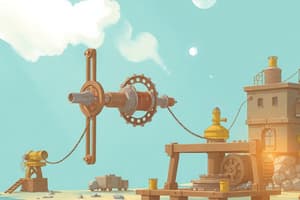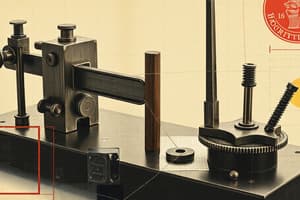Podcast
Questions and Answers
What is the main purpose of a lever?
What is the main purpose of a lever?
- To classify levers based on their mechanical advantage
- To pivot around a fixed point
- To reduce the amount of force required to perform a task (correct)
- To increase the amount of force required to perform a task
How is the mechanical advantage of a lever defined?
How is the mechanical advantage of a lever defined?
- The type of material used in the lever
- The ratio of the effort arm to the load arm (correct)
- The weight of the lever
- The length of the fulcrum
Which type of lever has the effort arm longer than the load arm?
Which type of lever has the effort arm longer than the load arm?
- Class 1 Levers (correct)
- Class 3 Levers
- Class 4 Levers
- Class 2 Levers
What is the function of the fulcrum in a lever?
What is the function of the fulcrum in a lever?
Which of the following is an example of a Class 1 lever?
Which of the following is an example of a Class 1 lever?
How does a lever make it easier to move a heavy object?
How does a lever make it easier to move a heavy object?
What is the defining characteristic of Class 2 levers?
What is the defining characteristic of Class 2 levers?
Where should the fulcrum be placed in order to effectively use a lever?
Where should the fulcrum be placed in order to effectively use a lever?
What is the mechanical advantage of a Class 3 lever?
What is the mechanical advantage of a Class 3 lever?
Which simple machine is an example of a Class 2 lever?
Which simple machine is an example of a Class 2 lever?
In what industry are levers commonly used?
In what industry are levers commonly used?
What is the main purpose of using a lever?
What is the main purpose of using a lever?
What determines how much force is required to lift a load using a lever?
What determines how much force is required to lift a load using a lever?
What is the defining characteristic of Class 3 levers?
What is the defining characteristic of Class 3 levers?
What type of lever has the load arm longer than the effort arm?
What type of lever has the load arm longer than the effort arm?
Why are levers considered versatile tools?
Why are levers considered versatile tools?
Flashcards are hidden until you start studying
Study Notes
Simple Machines: Understanding Levers
Simple machines are devices that make work easier by reducing the amount of force needed to perform a task. One of the most common simple machines is the lever, which is used to amplify force and transfer it to another point. In this article, we'll explore the basics of levers and how they work.
What is a Lever?
A lever is a simple machine that consists of a rigid bar that pivots around a fixed point called a fulcrum. The lever is used to amplify force, which means it can make it easier to move a heavy object. Levers are classified based on their mechanical advantage, which is the ratio of the distance from the fulcrum to the point where the load is applied (effort arm) to the distance from the fulcrum to the point where the force is applied (load arm). The mechanical advantage of a lever determines how much force it can amplify.
Types of Levers
There are three main types of levers, which are classified based on the relationship between the effort arm, load arm, and mechanical advantage. These types are:
-
Class 1 Levers: In this type of lever, the effort arm is longer than the load arm. This means the mechanical advantage is greater than 1, which allows the lever to amplify the force applied. Examples of Class 1 levers include scissors, nutcrackers, and shears.
-
Class 2 Levers: In Class 2 levers, the load arm is longer than the effort arm. This means the mechanical advantage is less than 1, which means the lever reduces the force applied. Examples of Class 2 levers include wheelbarrows, crowbars, and crutches.
-
Class 3 Levers: In Class 3 levers, the effort and load arms are of equal length. This means the mechanical advantage is exactly 1, which means the lever does not amplify the force applied. Examples of Class 3 levers include seesaws, pulleys, and pliers.
How to Use a Lever
To use a lever effectively, it's essential to understand where to apply force and where to place the fulcrum. The fulcrum should be placed where the load is applied, while the effort should be applied at the other end of the lever. The mechanical advantage of the lever determines how much force is required to lift the load.
For example, imagine using a wheelbarrow to move a heavy load. The wheelbarrow's fulcrum is located near the front wheel, while the load is placed near the back wheel. To lift the load, you would apply force to the handle, which is at the other end of the lever. The mechanical advantage of the wheelbarrow is less than 1, which means you would need to apply more force to lift the load than the load actually weighs.
Applications of Levers
Levers have numerous applications in daily life, from simple tools like hammers and pliers to more complex machines like cranes and elevators. They are also used in various industries, such as construction, manufacturing, and transportation.
Conclusion
In conclusion, levers are simple machines that help amplify force and make tasks easier. By understanding the different types of levers and how to use them effectively, you can make the most of this versatile tool. Whether you're lifting a heavy object or performing a delicate task, a lever can help you get the job done with ease.
Studying That Suits You
Use AI to generate personalized quizzes and flashcards to suit your learning preferences.



